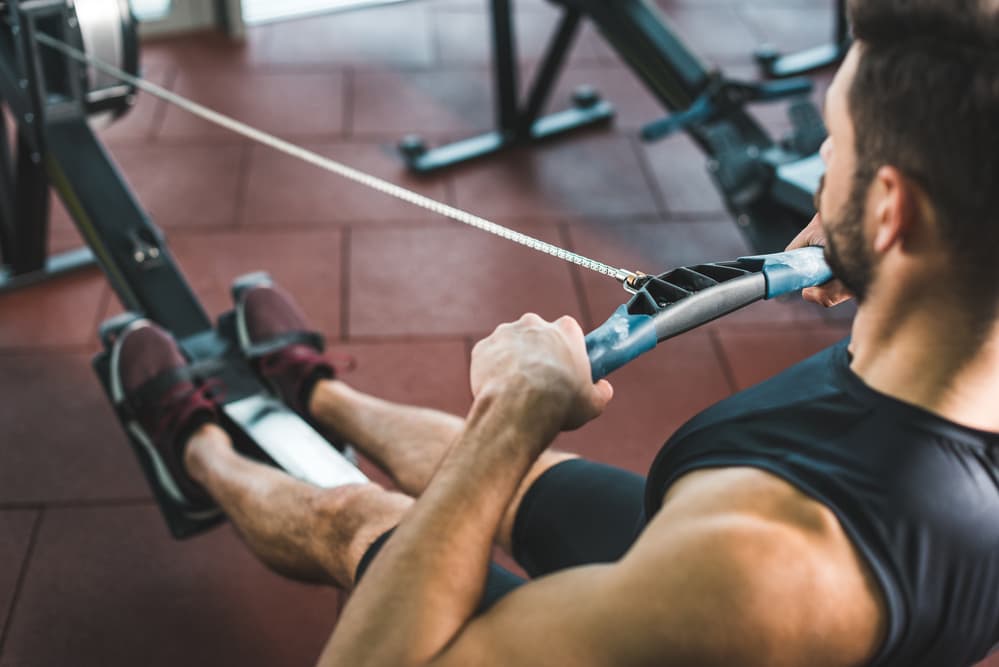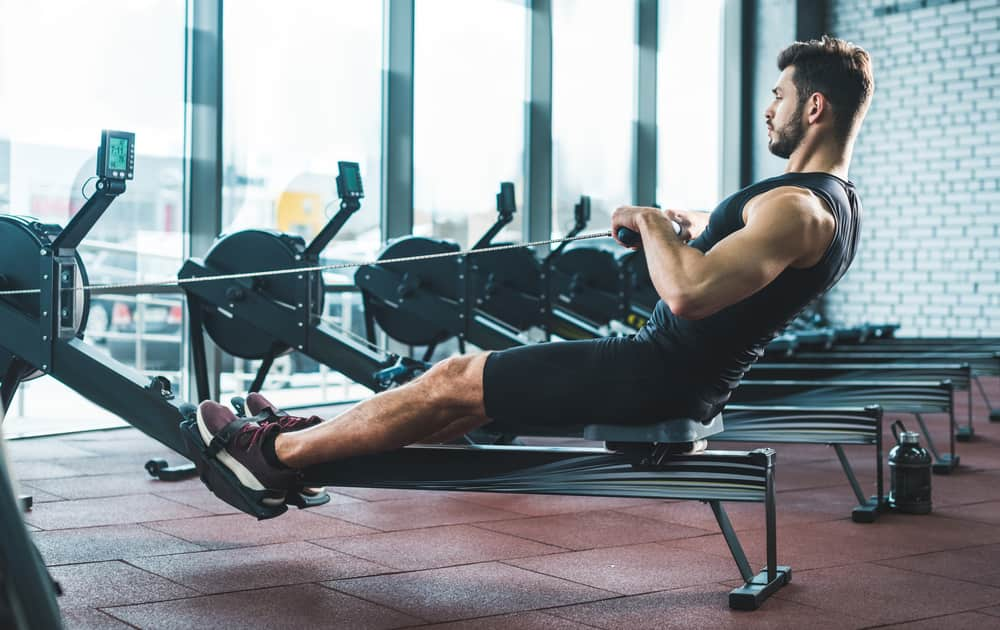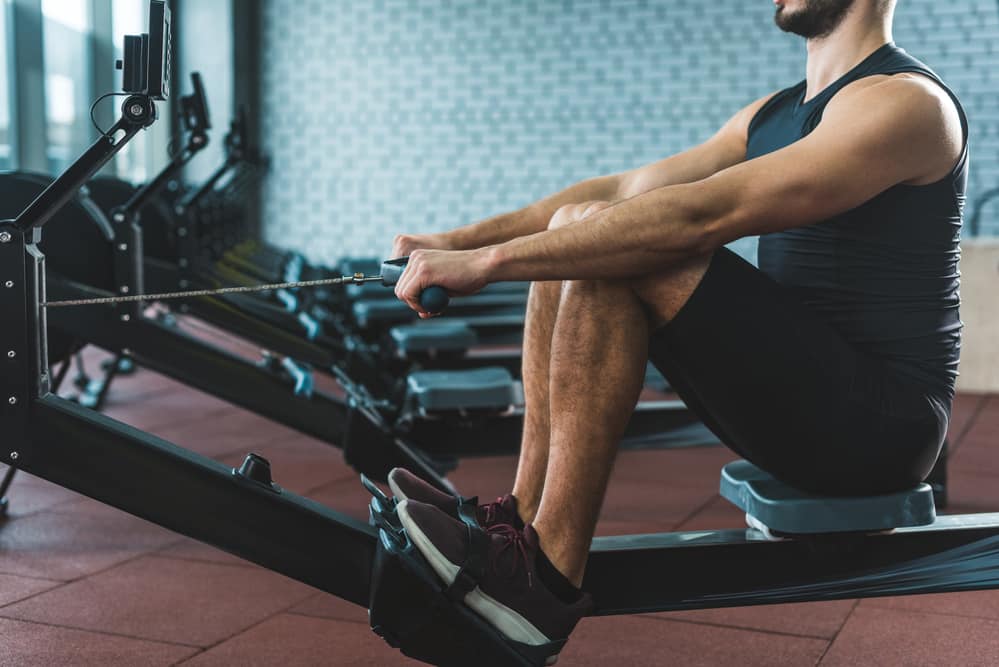Rowers are excellent calorie burners as completing a full stroke involves several muscle groups. The more muscles you work, the more calories you burn. But what does a rowing machine tone exactly?
A rowing machine targets over 80% of your muscles. Specifically, each rowing stroke is 65-75% leg work, which includes your glutes, quads and calves (AFPA 2013). It’s also a 25-35% upper body workout involving your arm, chest, upper back and core muscles.
Let’s break this down further by analysing the muscles toned for every part of your rowing stroke.
Keep reading and pick up a few other tips to maximise muscle activation while rowing.
How Do Indoor Rowing Machines Work the Muscles?
A rowing stroke has four vital phases. And each part works for specific muscle groups.
Understanding this muscle distribution can help you learn the proper rowing form and, in turn, tone the right muscles.
The Catch
This phase is your starting position. To do this, slide the seat all the way forward.
Bend your knees up close to your chest. Then, keep your arms straight while your shins are vertical to the ground.
Your body should also be slightly leaning forward.
What does a rowing machine tone during the catch phase?
This position tones your:
- Leg muscles. As you hold your shins in a vertical position, you are also compressing your glutes, hamstrings and calves.
- Back muscles. The catch phase activates your latissimus dorsi as you extend your arms. You also target your trapezius muscles and rhomboids while controlling your shoulder blades.
- Triceps. Your triceps activate when you extend the arms and elbows to the front and hold the handlebar.

The Drive
This phase counts as your first rowing movement. Start by pushing your feet off the foot stretchers and extending your legs.
Swing your body from leaning to an upright position by using your hips and engaging your core.
Next, activate your arms, shoulders and back as you pull the handlebar towards your sternum. You should complete these rowing movements in one fluid motion.
What does a rowing machine tone during the drive phase?
This combination of rowing movements tones your:
- Leg muscles. The drive phase contracts the hamstrings and glutes as you extend your hips and lean back your upper body.
- Shoulder muscles. These contract as you push your body back into an upright position.
- Biceps. Pulling the handlebar towards your chest works your arm muscles.
- Core. Your abdominal muscles activate as they keep your body stable when you pull the handlebar close to your ribcage.
- Back muscles. The back keeps your hinged lower and upper body stable during the drive phase.
The Finish
In this phase, your body is already slightly leaning towards the back, with your core keeping your body stable.
The handlebar is close to your sternum. Your legs should be fully extended at this point, too.
Make sure to keep your core activated and tight.
What does a rowing machine tone during the finishing phase?
This position tones your:
- Chest. Your upper body will be in a hanging position during the finishing phase. In turn, this activates the muscles of your torso, primarily the rectus abdominis, internal abdominal oblique, external abdominal oblique, pyramidal and transverse abdominis.
- Biceps. The finish phase targets your arm muscles as they contract to stabilise your back muscles.

The Recovery
This phase is doing the first three steps in reverse.
Do this by relaxing your arms away from your torso. Extend them out in front towards the flywheel.
Then, hinge your hips forward and bend your knees, pulling yourself forward. Keep sliding down the rail until you return to the catch position.
Note that your recovery should be half the speed of your drive phase to prep your muscles for the next strong push.
What does a rowing machine tone during the recovery phase?
This combination of rowing movements tones your:
- Triceps. You activate your triceps as you extend the arms and elbows forward.
- Leg muscles. Sliding down the rail and going back to starting position activates your upper and lower body. Specifically, the recovery phase contracts the hamstrings, glutes and calves.
How Can I Optimise Muscle Activation?
Here are some tips to add to your rowing routine for maximum muscle toning.
Maintain the proper rowing form
Observing the correct form optimises your indoor rowing machine workout routine and reduces the risk of injury.
One good piece of advice to follow is to lean from your hips during the catch phase rather than round your back.
If you maintain this tall posture, you’ll engage your core and back muscles more.
Drive your legs back first before pulling your arms
People often pull their arms first and then extend their legs. Doing this will only tire you out too soon.
Try to avoid that error by driving your legs first, then pulling your arms towards your chest next.
Remember that your legs do most of the work when rowing.
So, use them to pull yourself into an upright or leaning position, not your arms.

Practice rowing on a good, steady flow
Unlike other forms of exercise, rowing is not about speed. It’s more about pushing and pulling your body correctly to work many muscles.
Rowing too fast often disrupts your form. It will only activate the wrong muscles, tire you out quicker than usual or lead to injury.
Keep a relaxed pace that’s challenging enough.
Complement your fitness routine with a healthy diet
Here are some dietary habits you can do for better muscle toning effects:
- Eat three servings of lean protein daily. Protein is essential for muscle building and repair. So, eat one protein source for every meal. The best sources are those low in calories and fat, like chicken, fish and tofu.
- Boost your fresh fruit and vegetable intake. Eating more fruits and veggies can help you burn fat and enhance muscle tone. They’re also perfect for snacking without the empty calories. Some good choices are asparagus, broccoli, cauliflower, apples, bananas and strawberries.
- Incorporate healthy fats into your meals. Fat is a vital component of a balanced diet fit for muscle toning. But choose the healthy kind like avocado or olive oil. Salmon, sardines and tuna are good sources of omega-3 fatty acids, too.
- Enjoy one serving of fat-burning food daily. Foods that boost fat loss can help improve your muscle tone.
Conclusion
An indoor rowing machine tones a lot of muscles with every stroke.
While your legs will do most of the work, your upper body gets to shape up, too.
And the best part is you can achieve this without hurting your joints.
However, you do need to master the proper exercise form for maximum results.
It also helps if you complement your muscle-toning routine with a healthy diet and, of course, a reliable rower.
Not sure which row machine to get yet?
My reviews and buying guide can help you find the best indoor rowing machine for your space and budget.
Also, if you have other questions about rowing machines, click on this link to access the guide.
Related Questions
1. Does rowing make you bulky?
A regular rowing session will not cause your legs and thighs to bulk up or make you look like a professional bodybuilder. Rowing is a cardio workout, giving you a healthier physique and toned muscles. You can amplify these rowing benefits by pairing your exercise with a low-calorie diet rich in vitamins and minerals.
2. Which type of rowing machine is best for toning muscles?
Water and air rowers usually lack pre-set resistance levels, making them the best types for toning your muscles. With these types, the machine adapts to your fitness level, and you get higher resistance as you pull faster. Another good option is the air with a magnetic resistance rower. Here you get extra resistance without increasing your rowing speed. You can learn more about the different types of rowing machines here.
- Foldable vs Traditional Reformers: Which One’s Right for You? - 2 July 2025
- Elliptical Cross Trainer vs Exercise Bike: Which is Better? - 24 June 2025
- How Do the Different Massage Gun Attachments Work? - 23 June 2025
